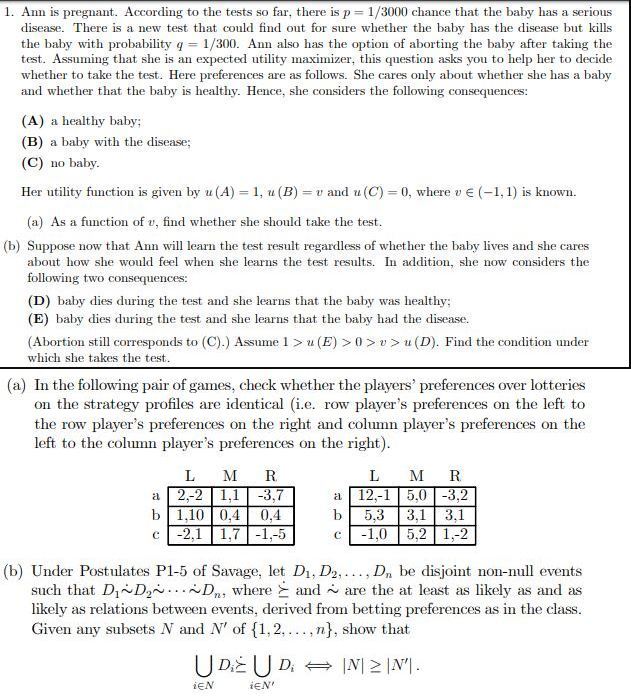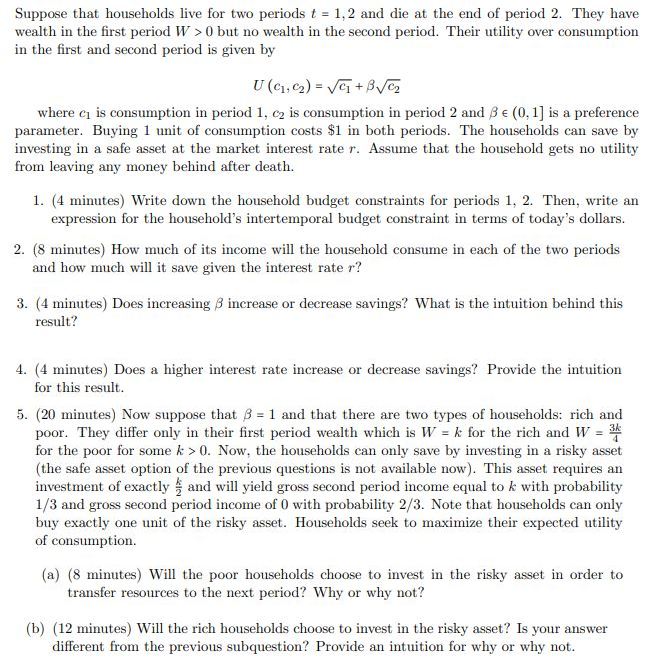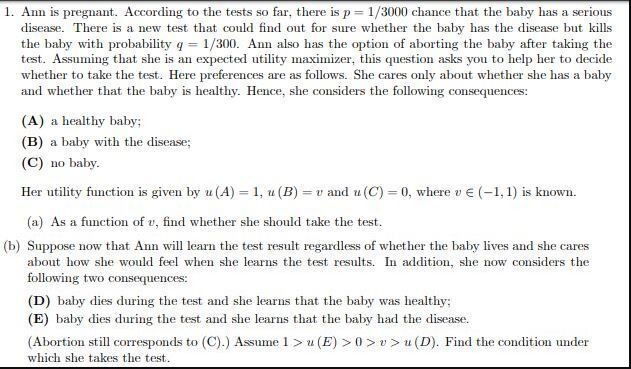Some microeconomic questions have been given below, provide answers for these
1. Ann is pregnant. According to the tests so far, there is p = 1/3000 chance that the baby has a serious disease. There is a new test that could find out for sure whether the baby has the disease but kills the baby with probability q = 1/300. Ann also has the option of aborting the baby after taking the test. Assuming that she is an expected utility maximizer, this question asks you to help her to decide whether to take the test. Here preferences are as follows. She cares only about whether she has a baby and whether that the baby is healthy. Hence, she considers the following consequences: (A) a healthy baby; (B) a baby with the disease; (C) no baby. Her utility function is given by u (A) = 1, u (B) = v and u (C) =0, where ve (-1, 1) is known. (a) As a function of v, find whether she should take the test. (b) Suppose now that Ann will learn the test result regardless of whether the baby lives and she cares about how she would feel when she learns the test results. In addition, she now considers the following two consequences: (D) baby dies during the test and she learns that the baby was healthy; (E) baby dies during the test and she learns that the baby had the disease. (Abortion still corresponds to (C).) Assume 1 > " (E) > 0 > > > u (D). Find the condition under which she takes the test. (a) In the following pair of games, check whether the players' preferences over lotteries on the strategy profiles are identical (i.e. row player's preferences on the left to the row player's preferences on the right and column player's preferences on the left to the column player's preferences on the right). L M R L M R 2.-2 1,1 -3.7 12,-1 5.0 -3.2 1,10 0,4 0,4 5.3 3,1 3.1 -2,1 1,7 -1,-5 -1,0 5,2 1,-2 (b) Under Postulates P1-5 of Savage, let D1, D2. .... D,, be disjoint non-null events such that Di~Dy~. . .~Dn, where > and ~ are the at least as likely as and as likely as relations between events, derived from betting preferences as in the class. Given any subsets N and N' of {1, 2. ..., n}, show that UD UD - IN12 INI. iEN iEN!Suppose that households live for two periods t = 1,2 and die at the end of period 2. They have wealth in the rst period W 2- [l but no wealth in the second period. Their utility over consumption in the first and semnd period is given by Ui1521= EE'I-v where c1 is consumption in period 1, cg is consumption in period 2 and 13 E [i]. l] is a preference parameter. Buying 1 unit of consumption costs $1 in both periods. The households can save by investing in a safe asset at the market interest rate 1*. Assume that the household gets no utility from leaving any money behind after death. 1. {4 minutes) Write down the household budget constraints for periods 1. 2. Then, write an expression for the household's intertemporal budget constraint in terms of today's dollars. 2. {3 minutm} How much of its immme will the household consume in each of the two periods and how much will it save given the interest rate r? 3. (4 rninutm} Does increasing ,5 increase or decrease savings? What is the intuition behind this result? cl. {4 minutes} Does a higher interest rate increase or decrease savings? Provide the intuition for this result. 5. {20 minutes} Now suppose that 13 = 1 and that there are two types of households: rich and poor. They differ only in their rst period wealth which is W = Jr for the rich and W = for the poor for some It 2: [1. Now. the households can only save by investing in a risky asset {the safe asset option of the previous questions is not available now]. This asset requires an investment of exactly '3' and will yield gross second period income equal to l: with probability US and gross second period income oil] with probability 2H. Note that households can only buy exactly one unit of the risky asset. Households seek to maximise their expected utility of consumption. {a} {3 minutes] Will the poor households choose to invest in the risky asset in order to transfer resources to the next period? Why or why not? (b) {12 minutes] 1Will the rich households choose to invat in the risky asset? Is your answer different from the previous subqution? Provide an intuition for why or why not. \f









